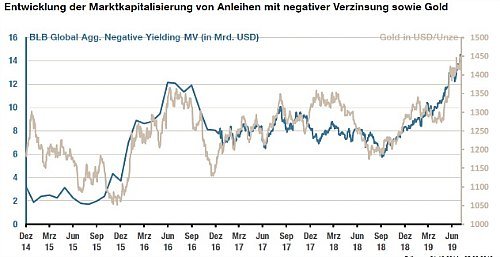Gold was already the investment of the month in July, but now the outlook has become even more bullish. In fact, the price of the precious metal today correlates with an index of pain.
U.S. investment banks have taken note: gold is the asset class of the summer 2019. Bank of America Merrill Lynch is predicting the metal to reach a record of $2,000 an ounce within two to three years. Goldman Sachs and J.P. Morgan were equally bullish in their recent analysis.
Signs are that the banks may turn out to be spot on with their predictions. In early August, the price of an ounce broke through a technical barrier at $1,450 and since has kept above $1,500.
And That's for Starters
The gold bull market has only just started, Gerald Celente, a popular trend analyst in the U.S., said recently. Tollowing the breakthrough, the way right to the level of $2,000 is wide open, according to Celente.
Both economic and monetary policy are favorable for gold: a crisis in Italy, trade war between China and the U.S., Brexit, Iran – you name it, the geopolitical risks are manifold and the with them go risks for the economy. Risks that are prompting investors to buy so-called safe assets – such as gold.
Central Bank Activity
The decision by the U.S. Federal Reserve to cut rates by a quarter point last month added momentum, because the step likely was the first in a new cycle for the central bank.
The «Fed Watch Tool», a prediction tool developed by CME, says that the likelihood of another cut by 25 basis points in September is 78.8 percent. For an even deeper cut of 50 basis points, the tools predicts a 21.2 percent likelihood. And purchases by central banks will also help gold reach new heights.
What Security?
And if even central banks are opting for the relative safety of gold as an asset, investors will have taken note. Safe investment has been used in connotation with the precious metal again, after a lengthy period when investors shunned gold.
With government bonds less attractive due to the minute or non-existent return, institutional investors are likely to opt for the relative safety of gold.
The Pain Index
The number of securities that don't return any yield has grown substantially, as a list of countries compiled by «Bloomberg» showed.
- Denmark: 100 Prozent
- Germany: 98 Prozent
- Holland: 93 Prozent
- Sweden: 90 Prozent
- Finnland: 90 Prozent
- France: 75 Prozent
- Japan: 71 Prozent
- Austria: 69 Prozent
- Ireland: 61 Prozent
- Portugal: 56 Prozent
- Spain: 53 Prozent
- Italy: 6 Prozent
- U.S.: 0 Prozent
The price of gold develops in close correlation with the market cap of securities with negative rates of return, Sven Lehmann, fund manager with Germany's HQ Trust, recently pointed out (see graph below).

There are no signs that bonds soon will start returning a yield again and as U.S. rates have also started to give way, the gold price stands to profit. So, «gold bugs», who kept faith in the precious metal for years and who have had their credibility questioned, have been proven right.

































